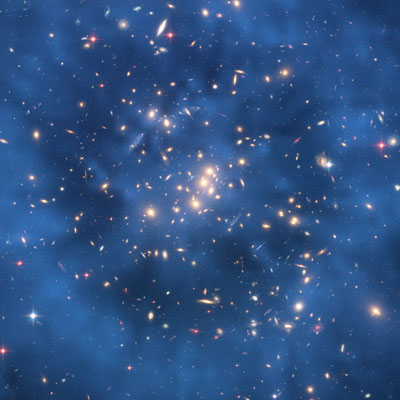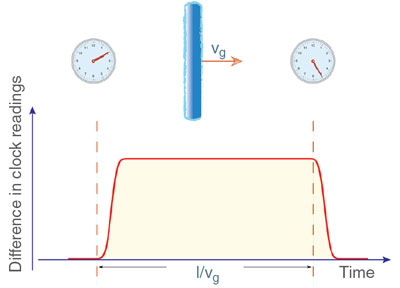Like many physicists today, Rafael Lang at Purdue University is on the hunt. As in a treasure hunt, the odds of finding the treasure may be slim, but the rewards are huge and the lure of the hunt irresistible. Lang said, “If we were to find something, it would be super, super exciting, another puzzle piece to open this new world.”
They are looking for the rest of the universe’s matter. Scientists have calculated that some 25 percent of the matter in the universe is not accounted for. They know something is out there because it is exerting gravitational pull on things that we can see. As light from distant stars passes through a galaxy, for example, the gravitational pull of the galaxy bends the light, as if it were passing through a lens. But when scientists measure the mass of the galaxy, and when they study this bending of light using space telescopes, there is more bending than there should be, so something else is out there, pulling. But they do not know what it is, or even what it is like. Maybe it could be passing through you right now as you sit. “There is much more to the universe than meets the eye,” Lang said.
What is the matter?
What Lang and others are looking for is a kind of matter that apparently does not reflect light. In our everyday understanding of the universe, we think of it being made of stuff that can be divided down into smaller and smaller components, until we reach some fundamental particles. Though these particles are too small to see with the naked eye, they can interact with us and so can be detected with instruments and experiments.
But the missing matter eludes detection by the usual means. Scientists have nicknamed it dark matter. They are sure it exists, but they know almost nothing about it.
“Dark matter is transcendent. There is dark matter in your office. Think of it like matter that is everywhere,” Lang said.
Several theories have been put forth about the nature of dark matter. Then physicists design experiments that confirm or disprove these theories. “You need to have ideas on how to search for it. If you don’t try to find it you’ll never know,” Lang said.
Until recently it has been generally accepted that dark matter is particulate in nature. Lang has been on a team looking for evidence of dark matter particles. “We look for evidence of change. Like I can look at that sofa: if there are cat hairs on it, then I know the cat has been there, the cat has left something behind,” Lang said. Researchers may construct complex, specialized research instruments based on these theories that detect interactions between dark matter and other matter.
Defective knowledge
However, other researchers have postulated that dark matter is something else entirely, that it is not particulate. Instead, what if it is some kind of irregularity in the fabric of space and time? They call this a topological defect, thought to be caused when the universe was cooling, a sort of crack in space.
Lang gave an analogy. “There’s a wedding and a hundred people are sitting at this big round table. Somebody starts eating the salad. They pick up the fork on their left, so the person next to them has to pick up the fork on the left. Now the bride also starts eating, picking up the fork on the right, so everybody around the bride picks up the right fork. At some point in between this poor guy will be sitting with no fork; on his other side will be someone with two forks. Those two guys are called a topological defect. There’s nothing special going on around the left, the right, but where those two guys are sitting, there’s a disruption of the forks.”
Physicist Andrei Derevianko at the University of Nevada, Reno thinks that dark matter may be organized as a large, gas-like collection of topological defects. If so, Derevianko and colleague Maxim Pospelov at the University of Victoria have proposed to detect it with instruments that are already available: atomic clocks.
A wrinkle in time
Atomic clocks are extremely accurate timepieces. A traditional clock may use a spring and balance wheel oscillating to mark time. An atomic clock counts the oscillations of an atomic electronic cloud. The atomic clocks that currently set the time standard for the U.S. use a fountain of cesium atoms to determine the exact length of a second; these clocks neither gain nor lose a second over about 100 million years, though even more accurate clocks do exist.
Geoff Blewitt at the Nevada Bureau of Mines and Geology explained how an array of atomic clocks could possibly detect dark matter. He said, “It might look like a wall between two parts of the universe. As the Earth is going around in our solar system and galaxy, we are passing through these walls once in a while. The laws of physics change very slightly as we pass through. This will affect an atomic clock. Andrei’s concept is that we could look for variations in atomic clock time.”
Derevianko and Pospelov have proposed that based on observations and simulations, astronomers have a good idea of how dark matter moves around the solar system. The defects would fly through the Earth at galactic velocities, approximately 300 kilometers (186 miles) per second. The dark matter would shift atomic frequencies, and as a clock swept through, it would become temporarily out of time with other atomic clocks. So they proposed to comb through atomic clock data to look for these out-of-sync nano-moments.
“You look for ways to find too many or not enough forks, you look for atomic clocks that eat the salad twice as fast because they have two forks, or don’t eat the salad because they have no forks, that’s what you look for,” Lang said.
Satellites and dark matter
While arrays of atomic clocks exist on the Earth’s surface, researchers were more intrigued by the array of atomic clocks in space. Thirty Global Positioning System (GPS) satellites each carry four atomic clocks aboard. GPS receivers on the ground use these time signals from GPS satellites to triangulate their position on the Earth. The greater spatial distribution of the clocks on the satellites gives researchers a much larger picture in which to look for these tiny, temporary time discrepancies. Blewitt said, "Based on Earth's rotation, one of our topological defects would pass through in 200 to 300 seconds. So we should look for glitches in satellite clocks, a pattern, a sweep across the whole constellation."
“We have all the technology in place because of the other applications of GPS. We have tremendous data to look at, really good data going back ten years,” Blewitt said.
Initially the team has been looking at GPS data from the International Global Navigation Satellite System Service (IGS) data archive at NASA's Crustal Dynamic Data Information System (CDDIS). “They publish data for every 30 seconds. We can do better than that,” Blewitt said. “GPS can give you data every second, so it’s really no problem to estimate every fifteen seconds.” As a next step, they are starting to look at the high-rate GPS data archive at CDDIS, which includes GPS, Russian Global Navigation Satellite System (GLONASS) satellites, and Europe’s Galileo satellites, sampled every second and distributed in near-real time.
Lang said, “That’s where their idea is so beautiful and fresh, and so generic. Plus it’s easy. All those atomic clocks are out there.”
So far the idea is holding up. If the researchers continue to see promising information in the data, they might further refine their search. For example, some of the clocks on GPS satellites are rubidium clocks, and some are cesium clocks. They might constrain their data to the more accurate cesium clocks, and possibly propose the development of a larger network of the most accurate clocks.
Blewitt said, “If we do it, it will be huge news. I’m not really expecting to see it; the chance of any one hypothesis working out is needle in a haystack. But you have to look.”
References
Derevianko, A., and M. Pospelov. 2013. Hunting for topological dark matter with atomic clocks. arXiv:1311.1244v1 [physics.atom-ph] 5 Nov 2013.
Atomic clocks knock on dark matter’s door.
NASA Crustal Dynamics Data Information System (CDDIS). Updated sub-hourly. Global Navigation Satellite System (GNSS) Data Archive. Greenbelt, Maryland USA.
For more information
NASA Crustal Dynamics Data Information System (CDDIS)
Global Navigation Satellite System (GNSS) data and product archive
International Global Navigation Satellite System Service (IGS)
| About the data | |
| Satellites | U.S. Global Positioning System (GPS), Russian Global Navigation Satellite System (GLONASS), European Space Agency Galileo |
| Sensors | Atomic clocks, GPS receivers |
| Data set | Daily 30-second data |
| Parameter | Time |
| DAAC | NASA Crustal Dynamics Data Information System (CDDIS) |
The image in the title graphic was taken by the Hubble Space Telescope and shows a galaxy cluster, catalogued as Cl 0024+17. The blue streaks near the center of the image are the smeared images of very distant galaxies that are not part of the cluster. The distant galaxies appear distorted because their light is being bent and magnified by the powerful gravity of Cl 0024+17, an effect called gravitational lensing. (Courtesy NASA, ESA, M.J. Jee and H. Ford/Johns Hopkins University)


